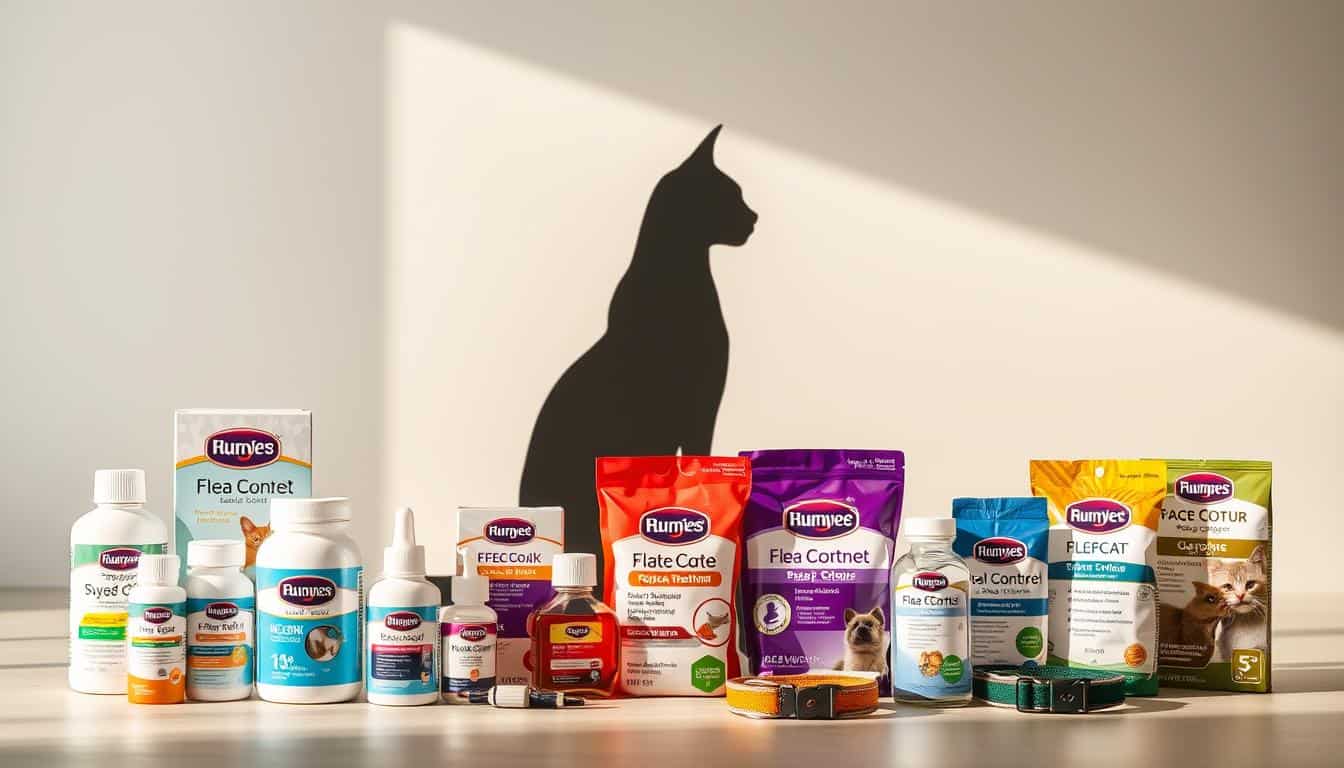I set out to compare the best options so you can choose safe, effective preventives that fit your home and your cat’s needs. I focus on how fast a treatment works, how long it lasts, which parasites it covers, and how it affects daily life.
Veterinarians in the United States recommend year-round prevention, even for indoor-only pets. Parasites can hitch a ride on people, other animals, or through shared walls, so I stress methods that stop infestations before they start.
I explain the main formats—topical spot-ons, oral tablets, and select collars—and how each fits different lifestyles. I also highlight safety points, including why dog-only items with permethrin are dangerous to cats and must never be used.
My goal is to make it simple to compare speed of action, duration, and parasite coverage, then match a treatment to your region and household. I also give practical tips to reduce mess and stress during application.
Key Takeaways
- Year-round prevention is recommended, even for indoor pets in the U.S.
- Oral options often act faster; topicals can irritate some animals.
- Never use dog-only formulations that contain permethrin on cats.
- Choose a format that fits your schedule and your pet’s comfort.
- Coordinate all household pets to break the infestation cycle.
Why I’m Reviewing flea control products for cats right now
My goal is to help you pick safe, reliable options today, before an infestation forces rushed decisions.
Activity from parasites continues through the year across much of the United States. Indoor pets remain at risk because pests can hitch a ride on clothing or travel between units in apartment buildings.
I get many reader questions about apartment exposure, multi-pet households, and first-time adopters who need clear dosing and safety guidance.
“I want straightforward advice that matches my ZIP code and budget,” a reader wrote recently.
Why update now:
- Regional parasite patterns shift with travel and moves, so last year’s choice may not fit today.
- Supply and pricing change; I note value per dose and multi-month plans.
- If a product didn’t work, I explain why and suggest alternatives that often solve the issue.
| Reason | Impact | Action I recommend |
|---|---|---|
| Year-round activity | Pets at steady risk | Choose continuous prevention |
| Regional shifts | Different threats by ZIP | Check local guidance |
| Supply/pricing | Budget pressure | Compare value per dose |
| Reader confusion | Safety worries | Recommend feline-specific options |
Editor’s note on safety: what veterinarians recommend before you buy
Before you buy any treatment, I always check species-specific labeling and active ingredients.
Species matters: why dog topicals can be dangerous
Some dog topicals such as K9 Advantix II contain permethrin. That ingredient is highly toxic to cats and can cause tremors, seizures, or death.
Labels on those dog items instruct keeping treated dogs separate from cats for 24 hours. I follow that guidance strictly in multi-pet homes.
When I consult my veterinarian and why prescriptions can be safer
Many veterinarians recommend prescription options because they have stronger safety data and proven efficacy in feline patients.
If a cat vomits after an oral dose, I call my veterinarian or the manufacturer right away to report the event and get redosing advice.
“I check the box, read the active ingredients, and call my clinic if anything looks ambiguous.”
- Check species labels: never substitute dog formulations (permethrin risk).
- Talk to your veterinarian for kittens, pregnant, underweight, or reactive pets.
- Keep packaging to verify weight ranges and emergency instructions.
- Review ingredients and avoid mixing actives without professional guidance.
| Issue | Risk | My action |
|---|---|---|
| Dog topical with permethrin | Seizures, tremors, death | Separate pets 24 hours; avoid use near cats |
| Vomiting after oral dose | Underdosing or reaction | Call veterinarian or manufacturer for redosing plan |
| Unclear ingredient list | Unexpected interactions | Consult veterinarian before use |
My at-a-glance picks by treatment type and coverage
I organize my picks by format so you can match a solution to your household quickly.
Quick summary: some options combine external parasite control with heartworm and intestinal worm protection. Others address only external pests and need add-ons.
- Topical spot-ons: clear feline dosing, localized application, good external coverage but variable skin sensitivity.
- Orals: fast-acting knockdown when immediate relief is needed; many list tick species killed after biting.
- Collars: long-duration protection and hands-off use when labeled specifically for cats.
“I weigh coverage, speed, and convenience to fit each home’s needs.”
| Format | Typical coverage | Duration |
|---|---|---|
| Topical | flea, some ticks | 1 month |
| Oral | flea, multiple ticks | 1 month |
| Collar | external parasites | 3–8 months |
My final tip: discuss the best option with your veterinarian so coverage matches regional risks and your cat’s health.
How I test and compare products for cats in the United States
I run hands-on trials in real U.S. households to judge how a treatment performs in everyday life. I watch outcomes that matter to owners: quick relief, lasting protection, and no bad reactions.
Real-world use: indoor-only, outdoor access, and multi-pet homes
I test in apartments with indoor-only cats, homes where pets go outside, and multi-pet households. This shows how transfer risks and shared spaces affect results.
Metrics I track
- I measure how fast a product kills fleas to stop biting and itching.
- I monitor long-term prevention of flea infestations across dosing cycles.
- I check ticks presence and label-listed species to assess true coverage.
Safety signals I record
I log any skin or hair changes at application sites and note odor or oiliness. For orals I track acceptance, vomiting, and redosing needs.
I avoid isoxazoline use in cats with seizure history and watch interactions in mixed-species homes to prevent accidental exposure.
Topical flea tick treatment options for cats
Topical spot-ons are a simple way I protect my pets without giving pills. A single-use tube applied to the skin can cover a month or longer and fits most household routines.
Pros and cons: spot-on convenience vs. skin irritation risk
I like topicals for their ease of use and steady protection. They may have a medicinal smell and can cause brief itching, irritation, or hair loss at the application site.
Some scented formulas are more likely to change the hair coat temporarily. If irritation appears, I contact my veterinarian and consider switching the active ingredient or the format.
Application tips: where to apply and how to keep pets and kids safe
I part the fur and apply between the shoulder blades or slightly down the back so the cat can’t lick the area.
- I make sure kids and other pets don’t touch the treated spot until it dries.
- In multi-pet homes, I separate playful companions until the product sets to avoid grooming transfer.
- Avoid bathing right before or after application if the label warns it may reduce effectiveness.
- I never substitute a dog topical that contains permethrin; it is unsafe for cats and must not be used.
- I store extra tubes in original packaging to check weight ranges and expiration dates before each use.
| Aspect | Benefit | Risk | My action |
|---|---|---|---|
| Monthly spot-on | Easy, no-pill routine | Site irritation, odor | Apply to back; watch site; call vet if severe |
| Scented formulas | May be more acceptable to owners | Hair changes, transient itching | Switch formula if hair loss appears |
| Household safety | Minimal handling once dry | Transfer risk to children/other pets | Block access until dry; separate pets if needed |
| Dog formulations | None appropriate for cats | Permethrin toxicity | Never use dog products on cats |
Oral treatments that kill fleas quickly
When I need rapid knockdown I reach for oral options that act through the bloodstream. They often relieve itching in hours and reduce live pests on the pet far faster than a topical application.
Fast knockdown vs. palatability:
How I make sure the dose is eaten: I offer the tablet with a small meal to improve acceptance and lower stomach upset. If my cat spits out the pill or vomits after dosing, I call the manufacturer or my veterinarian to get redosing guidance right away.
- I reach for an oral when I need something that kills fleas quickly and starts working within hours.
- For immediate relief I may use a short-acting option such as Capstar to knock down live pests within 24 hours, then follow with a monthly treatment like Comfortis if my vet recommends it.
- Orals avoid skin irritation and transfer risks in homes with children or other pets, but palatability can be a challenge; I use pill pockets or gentle pilling when needed.
| Option | Speed | Good use cases |
|---|---|---|
| Capstar | Hours to 24 hours | Immediate knockdown of active live pests |
| Comfortis | Within 24–48 hours, ongoing monthly | Heavier loads; part of a broader prevention plan |
| Monthly oral options | Hours to days | When bathing or topical transfer is a concern |
Flea collars for cats: when I use them and what I check on the label
A well-made collar can offer months of continuous coverage with less handling than spot-on or oral plans.
I consider a collar when I want a set-and-forget option that does not depend on monthly applications or pill acceptance. Many collars repel as well as kill, which can reduce tick attachment before a bite.
Before I buy I read the label for duration in months, whether it repels in addition to killing, and which tick species are listed. I confirm the item is cat-specific and the right size.
Safety matters: I check for a breakaway or release mechanism and watch the skin under the collar for redness or irritation. If problems appear, I remove the collar and call my veterinarian.
- I pair collars with separate heartworm or intestinal preventive when needed; collars protect only external pests.
- I avoid stacking external treatments without veterinary advice to lower reaction risk.
- In multi-pet homes I keep the collar snug but not tight and prevent other pets from chewing it.
- I set a calendar reminder for when efficacy ends and store spares sealed to preserve potency.
Travel note: if I visit a tick-heavy area I may add a repellent collar to complement baseline prevention and reduce attachment risk.
Prescription vs over the counter: how I choose the right product
When I weigh prescription versus over-the-counter options, I start with safety data and real-world results. My top priority is what gives the best odds of effective protection with the least risk to my pet.
Effectiveness, safety, and when I go Rx
Prescription options usually have stronger effectiveness and larger safety datasets. Most veterinarians recommend them, especially for cats with medical issues.
I choose an Rx when my pet has neurologic history, is underweight, or had prior reactions. I also prefer Rx when I need longer dosing intervals or combined parasite coverage.
OTC use cases and the limits of counter products
OTC items are handy when a vet visit is delayed. I still contact my veterinarian to confirm dosing and species appropriateness.
- Limitations: many retail items don’t cover heartworm or internal parasites and list fewer tick species.
- If an OTC product underperforms or irritates, I stop and switch under vet guidance rather than stacking actives.
- I track costs per dose and document what I tried and how my pet responded.
| Choice | When I use it | Key benefit |
|---|---|---|
| Prescription | Medical complexity or high-risk areas | Stronger data, vet support |
| Over-the-counter | Immediate access, temporary gaps | Easy to buy; check with vet |
Coverage matters: weeks vs months, ticks targeted, and heartworm protection
Knowing whether a treatment lasts weeks or months changes how I schedule refills and travel plans. I read labels carefully to match a product’s stated duration with my calendar and high-risk seasons.
Understanding labels: ticks listed, “kills” vs “repels,” and months of protection
I check which tick species are named and whether the label says the item “kills” after attachment or “repels” before a bite. Kills means activity after a tick latches on; repels lowers attachment risk and may reduce disease transmission time.
Pay attention to intervals: some brands dose every four weeks, others advertise multi-month coverage. Never assume dog intervals apply to feline formulations — durations can differ by species and formulation.
Heartworm, hookworm, roundworm: what’s included and what’s not
Some combined products include heartworm prevention and intestinal worm treatment. Others only handle external parasites and require separate medications for heartworm, hookworm, or roundworm.
- I match coverage to my cat’s lifestyle and local risk, adding heartworm meds when needed.
- I plan refills by weeks or months so coverage stays continuous during peak exposure.
- If a label lists fewer tick species than those common locally, I talk to my veterinarian about adding a repellent or switching the product.
| Claim | What I look for | My action |
|---|---|---|
| “Kills” | Post-attachment activity | Use when quick elimination is needed |
| “Repels” | Reduces attachment | Prefer in tick-heavy areas to lower bite risk |
| Multi-month dosing | Fewer applications | Confirm feline-specific interval and schedule refills |
If label language is unclear, I call the manufacturer helpline or my veterinarian for plain-English clarification. My aim is a simple, reliable regimen that covers external pests and heartworm without gaps.
Geography and risk: how the Companion Animal Parasite Council informs my picks
Where I live and where I travel shape which preventives I recommend most.
I start with the Companion Animal Parasite Council maps to see local parasite trends. The council’s region-specific prevalence data shows expanding ranges, such as the Gulf Coast tick moving up the East Coast and into parts of the Midwest.
Why regional tick species change my recommendation
I check which ticks are common in my county and whether heartworm rates are rising. If multiple species are present, I favor products that list those species on the label.
- I use CAPC data to decide if repellent action is worth adding during peak seasons.
- When I relocate or travel, I recheck maps before switching regimens.
- I compare labels side-by-side with local risks so coverage matches real exposure.
| Regional factor | What I look up | Typical action I take |
|---|---|---|
| High tick diversity | Named tick species on label | Pick product covering listed ticks |
| Gulf Coast tick expansion | Recent CAPC range maps | Reassess current regimen; add repellent if needed |
| Elevated heartworm in county | Local heartworm prevalence | Choose combined internal/external coverage |
My rule: I adjust plans only with vet agreement; otherwise, year-round protection stays my baseline.
Indoor cats need prevention too: fleas, apartments, and shared walls
Even when a cat never goes outside, parasites can arrive via visitors, clothing, or neighboring units. I keep my indoor-only cats on prevention because small hitchhikers reach my living space on shoes, laundry, and bags.
In multi-unit buildings, shared walls and hallways let pests move between units. I don’t wait for scratching to start; I stay on a steady dosing schedule to stop an infestation before it takes hold.
- I treat all household cats on the same day to reduce reservoirs.
- I vacuum rugs and furniture often and wash bedding to remove eggs and larvae.
- If a neighbor or roommate reports an issue, I double down on timely dosing and cleaning.
- I inspect screens, mats, and entry points and keep clutter low so cleaning works better.
| Risk | Action I take | Why it matters |
|---|---|---|
| Visitors or clothing | Ask pet-owning guests to limit contact | Reduces introduction sources into the home |
| Shared walls | Maintain continuous prevention and extra cleaning | Stops migration between units |
| New adoptee | Align their schedule with existing pets after vet OK | Prevents creating a new reservoir |
Continuous prevention builds a calm baseline so my pets relax without the itch cycle restarting. I view consistent flea control as essential to keeping my home comfortable and safe.
Sensitive cats and special cases: when I avoid isoxazoline ingredients
Not every regimen fits every feline; I change strategy when health or life stage raises questions. I start by reviewing medical history and current weight before I choose any active ingredient.
Why I avoid isoxazoline in some pets: those ingredients can lower the seizure threshold in animals with prior neurologic issues. If my cat has any seizure history, I skip isoxazolines and ask my veterinarian about safer alternatives.
I also pause and consult a vet when a pet is underweight, recovering from illness, pregnant, nursing, or intended for breeding. No preventive is started without discussing prior allergic reactions and current health status.
- I introduce new items one at a time so I can spot reactions quickly.
- I keep a log of product names, lot numbers, and dates to help my vet assess any adverse event.
- I monitor closely after the first dose for GI upset, itching, or behavior changes and call my clinic if I see trouble.
| Situation | My action | Reason |
|---|---|---|
| Seizure history | Avoid isoxazolines | Neuro risk |
| Pregnant or nursing | Use only vet-endorsed options | Protect offspring |
| Underweight or ill | Delay and consult vet | Reduce adverse events |
Bottom line: safety first—I tailor every choice with my veterinarian so treatment cats get protection with the lowest possible risk of harm.
Ingredients I look for—and those I avoid around cats
A product’s active ingredients decide whether it suits a healthy pet, a senior, or one with neurologic risks. I start by scanning the active-ingredient panel and species warnings before format or price.
Isoxazolines are powerful against fleas and ticks and often work fast. I use them cautiously in animals with any seizure history and discuss risk with my veterinarian medical team before starting them.
Imidacloprid has a long record of safe flea reduction when formulated for felines. I prefer feline-specific labels and dosing ranges to limit skin or systemic issues.
What I strictly avoid and checklist I use
- I never use permethrin-containing items around my pets; permethrin is toxic to cats and can cause severe reactions.
- I check that repellent claims list feline approval and no cat-unsafe actives.
- I do not layer multiple topicals unless a vet explicitly approves the mix.
- In homes with dogs, I keep dog-only items separate and follow label separation instructions to protect sensitive cats.
| Ingredient | Use | Concern |
|---|---|---|
| Isoxazoline | Fast flea and tick kill | Avoid if seizure history |
| Imidacloprid | Proven flea reduction | Use feline-specific formulas |
| Permethrin | Dog repellents | Toxic to cats; avoid exposure |
Bottom line: I weigh speed of kill, breadth of coverage, and my pet’s health with my veterinarian. Reading labels and confirming feline approvals keeps my household safe.
How I apply, dose, and schedule treatment to control household infestations
When an outbreak begins, I take a simple, repeatable approach: treat every animal and clean key areas on a fixed timetable. That coordinated plan helps end active flea infestations and prevent quick reintroduction into the home.
Coordinating all pets in the home for 4–8 weeks
I dose every pet on the same day and keep them on schedule for at least 4–8 weeks. Syncing doses removes reservoirs and shortens the life cycle.
I set calendar reminders by weeks so I don’t miss follow-up doses. Skipping one animal can undo weeks of work.
Environmental steps: laundry, vacuuming, and reducing reinfestation
I vacuum carpets, rugs, and furniture often and discard the bag or empty the canister immediately. That removes eggs and larvae while treatment takes effect.
- I wash bedding and throws on hot cycles to kill immature stages.
- I avoid bathing pets right around topical application unless the label allows it.
- I repair screens, reduce clutter, and limit shared-laundry or visitor risks that bring fleas back inside.
If I need fast relief, I use a quick-acting oral while monthly treatment builds longer-term protection. Persistence pays off—consistent steps restore comfort in the home.
What I avoid when cats and dogs live together
When dogs and cats share a home, I take clear steps to prevent accidental exposure during treatment days.

Why I’m strict: some dog topicals contain permethrin, which is highly dangerous to toxic cats. Labels often say to keep treated dogs away from felines for 24 hours, and I follow that guidance without fail.
My checklist:
- I never use dog-only products near my cats and keep permethrin-containing items well away from shared spaces.
- On dog dosing days I separate species for at least 24 hours and supervise until any topical dries.
- I avoid letting cats sleep in a dog’s bed or lie on a collar right after application.
- I store dog and cat items separately to prevent mix-ups and read labels out loud before dosing.
- In tight homes I prefer feline orals to reduce transfer risk from sofas and shared throws.
If exposure occurs: I call my veterinarian immediately and bring the package. A small amount of planning keeps both pets safe and reduces the chance of a house-wide flea or ticks problem.
Budgeting for control: price ranges, value per dose, and multi-month plans
I budget prevention the same way I budget routine vet care: by cost per dose and long-term value.
I compare cost per dose, not just sticker price. Multi-count boxes often reduce the average price even though the upfront spend is higher.
My rule: plan in quarters or six months so I don’t skip a dose when money is tight. I check weight-band color codes on the box to avoid returns or wasted doses.
- I watch manufacturer rebates and pharmacy auto-ship discounts to lower monthly costs.
- If I choose counter options to save, I confirm safety with my vet and reassess if results lag.
- I avoid stretching intervals — lapses invite infestations that cost more to fix.
“Compare per-dose cost and convenience; paying a little more for fewer doses can improve compliance.”
| Pack type | Average cost per dose | Best use |
|---|---|---|
| Single-dose | High | Immediate need |
| Multi-count | Lower | Long-term savings over months |
| Subscription | Variable | Consistency and convenience |
Bottom line: smart planning makes continuous flea control affordable without compromising my pet’s protection or the health of my cats.
Work with your veterinarian: the confident path to a flea- and tick-free cat
I partner with my veterinarian to make tailored choices that match my household and local parasite risks.
I rely on a vet to match coverage to my cat’s health, region, and lifestyle. Veterinarians recommend year-round prevention and can simplify options into a few safe, effective picks.
My veterinarian helps me weigh ingredient tradeoffs if my pet has sensitivities or neurologic history. Together we set dosing schedules, refill reminders, and environmental steps that stop flea and tick return.
I report scratching, vomiting, or skin changes so adjustments are evidence-based. With trusted vet support, I stay confident my pet is protected against parasites while avoiding unnecessary risks.




